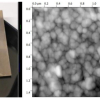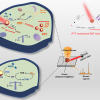
One solution to agriculture’s many challenges—climate change-induced drought, less arable land and decreased water quality, to name but a few—is to develop smarter fertilisers. Such fertilisers would aim not only to nourish the plant but also to maximise soil bacteria’s positive effects on the plant. Tapping into a plant’s microbiome may be the extra layer of defence crops need to thrive.
Researchers at Utah State University have used Raman spectroscopy to analyse the effects of two abiotic stressors on Pseudomonas chlororaphis O6 (PcO6), a health-promoting bacterium native to the roots of dryland wheat in northern Utah. They found that stress can cause compositional changes in the bacterium’s extracellular structures called outer membrane vesicles (OMVs). Scientists have long known that bacterial cells release OMVs, but this study asks what factors prompts their release and how the myriad functions of those structures can be leveraged for the crop’s benefit.
Raman spectroscopy coupled with a machine learning algorithm enabled the researchers to identify the type of stress the bacteria were experiencing when releasing these OMVs and the stress-dependent compositional changes therein. These observed changes have implications for cell-to-cell communication and bacteria–plant communication, which are essential to better understanding the microbiome.














